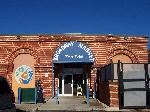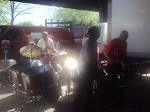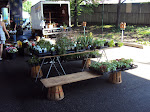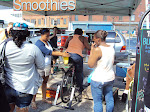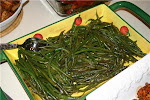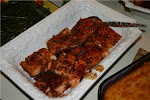Thursday, July 22, 2010
July CFNI Newsletter Released
The July issue of the Community Food and Nutrition Institute newsletter was released on the web, http://www.communityfoodandnutrition.org/Newsletter.asp.
Tuesday, June 22, 2010
Skillet Gathering Celebrating Juneteenth June 19, 2010
In the celebratory spirit of Juneteenth, the Community Food and Nutrition Institute (CFNI) held our first 2010 Skillet Gathering. For those of you who don’t know what Juneteenth is, here’s a little bit of history.
President Lincoln issued the Emancipation Proclamation on January 1, 1863. However, two and a half years later, on June 19, 1865, Union soldiers sailed into Galveston, Texas to announce the end of the Civil War, and read aloud General Order #3 freeing the quarter-million slaves residing in the state. The day became a celebration of former slaves who’d been denied the tools of literacy; Juneteenth helped them remember the day in oral history. In the past and now, Juneteenth celebrations commemorate the end of slavery and focus on education and self improvement. To this day traditional and popular foods include barbecue and strawberry soda. Communities spent their little money to buy common grounds to hold their Juneteenth celebrations on “emancipation grounds.” One of the earliest documented land purchases in the name of Juneteenth was organized by Rev. Jack Yates. This fund-raising effort yielded $1,000 and the purchase of Emancipation Park in Houston, Texas in 1872. Other communities across the state have similar parks. While Juneteenth is not yet recognized as a national holiday, it has been approved and celebrated as a state holiday in 36 states, including Arkansas, Texas, Florida, Oklahoma, Delaware, Alaska, Idaho, Iowa, California, Wyoming, Illinois, Missouri, Connecticut, Louisiana, New Jersey, New York, Colorado, Oregon, Kentucky, Michigan, New Mexico, Virginia, Washington State, Tennessee, Massachusetts, North Carolina, West Virginia, South Carolina and the District of Columbia.
So on June 19, 2010 the CFNI Skillet Gathering was a time to honor the ancestors, tradition, food and community. We welcomed family and friends. Appetizers were served. We recounted the history of Juneteenth. Thyme introduced one of our guests, a historian, who cited an ode to the ancestors. We all said “Ashay” in response to his cadence and some of us remembered loved ones who’ve passed away by calling out their names. Hot Pepper talked about the menu and why we picked the foods.
President Lincoln issued the Emancipation Proclamation on January 1, 1863. However, two and a half years later, on June 19, 1865, Union soldiers sailed into Galveston, Texas to announce the end of the Civil War, and read aloud General Order #3 freeing the quarter-million slaves residing in the state. The day became a celebration of former slaves who’d been denied the tools of literacy; Juneteenth helped them remember the day in oral history. In the past and now, Juneteenth celebrations commemorate the end of slavery and focus on education and self improvement. To this day traditional and popular foods include barbecue and strawberry soda. Communities spent their little money to buy common grounds to hold their Juneteenth celebrations on “emancipation grounds.” One of the earliest documented land purchases in the name of Juneteenth was organized by Rev. Jack Yates. This fund-raising effort yielded $1,000 and the purchase of Emancipation Park in Houston, Texas in 1872. Other communities across the state have similar parks. While Juneteenth is not yet recognized as a national holiday, it has been approved and celebrated as a state holiday in 36 states, including Arkansas, Texas, Florida, Oklahoma, Delaware, Alaska, Idaho, Iowa, California, Wyoming, Illinois, Missouri, Connecticut, Louisiana, New Jersey, New York, Colorado, Oregon, Kentucky, Michigan, New Mexico, Virginia, Washington State, Tennessee, Massachusetts, North Carolina, West Virginia, South Carolina and the District of Columbia.
So on June 19, 2010 the CFNI Skillet Gathering was a time to honor the ancestors, tradition, food and community. We welcomed family and friends. Appetizers were served. We recounted the history of Juneteenth. Thyme introduced one of our guests, a historian, who cited an ode to the ancestors. We all said “Ashay” in response to his cadence and some of us remembered loved ones who’ve passed away by calling out their names. Hot Pepper talked about the menu and why we picked the foods.
- Appetizer – grilled shrimp and mango salsa. Served because we wanted only one appetizer and this one was summery, cool, and had a little spice.
- Traditional Juneteenth Meal – barbeque chicken wings, potato salad, black-eye pea salad, collard greens, mini corn casserole cups, cold lemonade tea. These foods represented the traditional foods served during past celebrations.
- A Touch of Spain – food demonstration on how to make a Spanish-style tortilla served with homemade Sangria (alcoholic and non-alcoholic). We want to highlight another culture during our Skillet Gatherings. A friend from Spain was visiting and volunteered to make a Spanish tortilla, which is a combination of eggs, potatoes, onion, and anything else you want to add prepared on top of the stove in a skillet. She showed us how to make a plain tortilla and a chorizo tortilla.
- Dessert – peach cobbler a la mode and brown sugar & chocolate chip pound cake with maple espresso glaze. Thyme did a twist on the pound cake and Hot Pepper likes peach cobbler.
Our Skillet Gatherings are about community, food, and conversation. They also serve as a way to spread the word about CFNI and raise funds for our activities. This time around we featured aprons, t-shirts, and bags with the Skillet Gathering logo. Our yellow aprons were especially a big hit. If you’d like to order one of these items, click here.
Saturday, May 15, 2010
What's Haute in the City, Right in Thyme's Back Yard
Why am I so excited about this time of year? Yeah, I know you are thinking, because spring is in the air. Well, yes that is part of it. But I must confess it’s really because fresh fruits and vegetables are in the air. Let me start by saying, this is year 2 of “What’s Haute in the City, Right in Thyme's Back Yard.” Last year was my first foray into growing a vegetable garden and I think for a first timer, it went well. Well, why shouldn’t it, I am the descendant of a sharecropper. And one thing my grandfather and father knew was how to grow crops. This is year two, and I am excited because I have expanded just a little. On the list this year, Heirloom tomatoes, plum tomatoes, red, green, yellow and orange bell pepper; zucchini, eggplant, jalapenos, lettuce, and a variety of herbs. This is quite a task considering that my backyard is small and I have no dirt. City life is quite intriguing, you have to make do with what you have. However, I have space, so I decided that a container garden would do just the trick. I had a wonderful time planting my garden and because I didn’t have anyone to build my shelves for my container garden. I started my adventure by going to Lowe’s to get cement blocks to hold the 2x12x16 and set it up. This allowed me to build two 8 foot shelves. My garden has expanded, so look out for “What’s Haute in the City, Right in Thyme's Back Yard, Part 2,” coming later this summer.
Now let me talk about the opening of the farmers markets in Maryland, which occurs officially the first week of May. I always visit my favorite first, the Baltimore Farmers Market & Bazaar. This is the 33rd year and for the first time the market will open at 7 am, a whole hour earlier. In 2010, the market will be open from May 2 – December 19, every Sunday from 7 – 12. This is considered Baltimore’s largest producers only market. So let’s begin my sensory journey of the farmers market. It was my first time attending the market on opening day, and it was fantastic. The sound of the pan band, playing reggae music just added to the atmosphere. The weather was beautiful and I think for the most part everyone was anticipating the opening, because it seemed as though all of the city residents were there. The major items for sale were plants and herbs and I was able to begin my very own herb and lettuce garden. The local fruits and vegetables for sale included strawberries, apples, spinach, lettuce, and spring onions. I didn’t get to enjoy my usual pit beef because the line was so long. There was about an hour wait. Zeke’s Coffee was there as usual, and I waited 30 minutes to get a cup, it was well worth the wait. Now, the most interesting addition to the farmers market this year was the “Wheely Good Smoothie” stall. You choose your smoothie ingredients and then you hop on a bicycle and you peddle to make your own smoothie. It was quite comical and entertaining to say the least. Talk about getting your physical activity in. Visiting the farmers market is an amazing journey that I will likely make at least twice a month until December. The best part of the Baltimore Farmers Market & Bazaar is that I can enjoy fresh local foods through mid-December.
Now let me talk about the opening of the farmers markets in Maryland, which occurs officially the first week of May. I always visit my favorite first, the Baltimore Farmers Market & Bazaar. This is the 33rd year and for the first time the market will open at 7 am, a whole hour earlier. In 2010, the market will be open from May 2 – December 19, every Sunday from 7 – 12. This is considered Baltimore’s largest producers only market. So let’s begin my sensory journey of the farmers market. It was my first time attending the market on opening day, and it was fantastic. The sound of the pan band, playing reggae music just added to the atmosphere. The weather was beautiful and I think for the most part everyone was anticipating the opening, because it seemed as though all of the city residents were there. The major items for sale were plants and herbs and I was able to begin my very own herb and lettuce garden. The local fruits and vegetables for sale included strawberries, apples, spinach, lettuce, and spring onions. I didn’t get to enjoy my usual pit beef because the line was so long. There was about an hour wait. Zeke’s Coffee was there as usual, and I waited 30 minutes to get a cup, it was well worth the wait. Now, the most interesting addition to the farmers market this year was the “Wheely Good Smoothie” stall. You choose your smoothie ingredients and then you hop on a bicycle and you peddle to make your own smoothie. It was quite comical and entertaining to say the least. Talk about getting your physical activity in. Visiting the farmers market is an amazing journey that I will likely make at least twice a month until December. The best part of the Baltimore Farmers Market & Bazaar is that I can enjoy fresh local foods through mid-December.
Tuesday, April 13, 2010
CFNI Newsletter Launched
CFNI has a new logo for its Skillet Gatherings. A newsletter also was launched today titled "Notes on food in the community." It will be published quarterly and will feature a community organization profile, a community person profile, a column on food prices in your neighborhood, a food environment photo gallery, and a recipe. Take and look and enjoy! Let us know what you think. http://www.communityfoodandnutrition.org/HomePage.asp
Sunday, March 14, 2010
Hot Pepper Colombian Style
This time last year I was in Colombia on a short-term Fulbright grant. I lectured at a local university, visited various community-based organizations, lived with a wonderful family, and ate delicious food. My host family consisted of a mother (Lorena), her young son and daughter in one apartment and her parents upstairs in another apartment. We lived across the street from the university and walked back and forth to campus. Lorena’s parents (Faneth and Emilio), especially Emilio, prepared all the food. Talk about fresh, colorful, nutritious, and tasty. I loved it!!
A typical day started with breakfast, a hearty lunch, and a light dinner. My first breakfast included papaya, mango, and guanabana, grilled cheese/meat sandwich, orange juice, and coffee. After a couple of days I had to ask my host family to cut back on the breakfast because it was too much food for me. I’m usually a yogurt, little bit of granola, coffee breakfast eater.
Lunch was the highlight of the day. Lorena and I would walk home and up to her parents’ apartment. On March 4, I overslept a bit and didn’t get to campus until 9:45 a.m. I ate just a little pineapple, a slice of cheese, a cracker, and hot chocolate. I walked to campus alone for the first time (my host family was very protective). By lunch time I was starving. The food looked so good that I had to take a picture.
My March 4 lunch included pan fried chicken breast fillet; rice with fried vermicelli; plantain torte (cheese, milk, egg, flour, plantain); and avocado salad with chopped tomato, onion, green pepper, salt, lemon, vinegar. I ate two helpings of rice and salad. Afterwards we had coffee and a cookie (tasted like shortbread) and then they brought me some shaved coconut mixed with sugar and milk. Everything was delicious!!
March 5
Breakfast: papaya and mango, coffee, cheese and toast
Lunch: chicken and rice (arroz con pollo), beet salad, sweet plantain, juice, coffee
March 6
Breakfast: Activia strawberry yogurt, papaya and mango
Lunch: slivers of beef, lentils, rice, and plantain, fresh guava juice, coffee, and chocolate fudge-like dessert made with chocolate milk, lemon and sugar. Delicious!!
It was after this meal that I noticed how much coffee I was drinking each day, but it was because it tasted so good. Emilio made coffee from scratch. He roasted fresh coffee beans, constantly stirring them in a pot on a stove for about 20 minutes. He ground them in a blender; then brewed the coffee. You truly tasted the essence of the coffee, which is probably why I drank so much and drank it black with just a little sugar.
March 7
Breakfast: mango, papaya, Activia yogurt with pitaya (a local fruit)
Lunch: slices of marinated beef, rice, patacon` (fried green plantain), green beans and green onion cooked together
March 9
Lunch: lentils and rice cooked together, potatoes with some kind of sauce (I forgot to ask what), fried chicken (yes), and carrot salad. Lorena exclaimed, “an orange lunch!” I took a picture.
March 10
Breakfast: a little fruit, coffee and cornmeal based pancake filled with cheese
Lunch: cow tongue, rice cooked with plantain; cucumber and tomato salad; yucca prepared thinly, formed into a donut shape and fried. The juice was made from corn. I loved the food; the juice was an acquired taste.
Dinner: I drank water for the first time in a long while. Colombians drink “natural juices” more than water. I also had carimanola, something similar to a samosa but made with yucca as the outer shell and potato with a little meat as the filling. It also could be filled with cheese.
March 12
Breakfast: mango, papaya, coffee
Lunch: fried red Tilapia (whole), coconut rice, tomato and avocado salad, 2 patacon`, juice. I had started eating when Lorena’s mom reminded me to take a picture. I flipped my fish over to get a before-eaten picture!
During my two weeks in Colombia I ate a total of 3 junk food items; lemon flavored chips, lemon flavored chips with plantain and chicharron (pork rinds), and a strawberry soda. That’s what good, fresh food does to you. It diminishes your desire to eat junk.
March 13
Breakfast: empanada with a fried soft egg inside, mango, and coffee. For someone who doesn’t like fried eggs, I ate the whole thing. First, it actually tasted good. Second, I couldn’t see myself wasting any food there.
After breakfast Emilio took me to the Plaza Minorista, a huge food distribution center. It was magnificent and I could have spent the whole day there. The place was divided into sections by the type of food – fruit, vegetables, beans, bread, fish, and meat. And goodness did I see meat, whole pigs strung up, being carved up on the spot, and everything displayed in trays from the usual (intestines, chops, ribs) to the not so usual for American eyes (scrotum, nuts, pancreas, eyes)!! Cows were on display the same way. Nothing was wasted. Amazingly there was a smell, but it wasn’t that bad, probably because the meat was so fresh. I took several pictures. I also took pictures of different varieties of avocadoes, mangoes, pineapples, oranges packaged in mesh and strung up looking like balls of chimes, lemons, limes, carrots and potatoes neatly packaged in plastic bags, huge meaty fish sliced and presented like accordions, and pyramids of berries, kiwi, and plums.
Afterwards, we walked across the street and I bought two utensils, one for cutting plantain, the other for flattening them into patacon`. It was a wonderful morning and a fantastic way to begin my departure from Colombia.
In 2001, the Capital Area Food Bank published “From Farm to Table, Making the Connection in the Mid-Atlantic Food System.” It described the flow of food from local farms to distribution to consumption and food access. Seeing the Plaza Minorista made me want to learn more about how food is distributed in my area. Next stop for me will be a visit to my local food distribution center in Jessup, MD. Once farmers markets open up in spring, I’ll be off to see them as well. You’re welcome to come along.
A typical day started with breakfast, a hearty lunch, and a light dinner. My first breakfast included papaya, mango, and guanabana, grilled cheese/meat sandwich, orange juice, and coffee. After a couple of days I had to ask my host family to cut back on the breakfast because it was too much food for me. I’m usually a yogurt, little bit of granola, coffee breakfast eater.
Lunch was the highlight of the day. Lorena and I would walk home and up to her parents’ apartment. On March 4, I overslept a bit and didn’t get to campus until 9:45 a.m. I ate just a little pineapple, a slice of cheese, a cracker, and hot chocolate. I walked to campus alone for the first time (my host family was very protective). By lunch time I was starving. The food looked so good that I had to take a picture.
My March 4 lunch included pan fried chicken breast fillet; rice with fried vermicelli; plantain torte (cheese, milk, egg, flour, plantain); and avocado salad with chopped tomato, onion, green pepper, salt, lemon, vinegar. I ate two helpings of rice and salad. Afterwards we had coffee and a cookie (tasted like shortbread) and then they brought me some shaved coconut mixed with sugar and milk. Everything was delicious!!
March 5
Breakfast: papaya and mango, coffee, cheese and toast
Lunch: chicken and rice (arroz con pollo), beet salad, sweet plantain, juice, coffee
March 6
Breakfast: Activia strawberry yogurt, papaya and mango
Lunch: slivers of beef, lentils, rice, and plantain, fresh guava juice, coffee, and chocolate fudge-like dessert made with chocolate milk, lemon and sugar. Delicious!!
It was after this meal that I noticed how much coffee I was drinking each day, but it was because it tasted so good. Emilio made coffee from scratch. He roasted fresh coffee beans, constantly stirring them in a pot on a stove for about 20 minutes. He ground them in a blender; then brewed the coffee. You truly tasted the essence of the coffee, which is probably why I drank so much and drank it black with just a little sugar.
March 7
Breakfast: mango, papaya, Activia yogurt with pitaya (a local fruit)
Lunch: slices of marinated beef, rice, patacon` (fried green plantain), green beans and green onion cooked together
March 9
Lunch: lentils and rice cooked together, potatoes with some kind of sauce (I forgot to ask what), fried chicken (yes), and carrot salad. Lorena exclaimed, “an orange lunch!” I took a picture.
March 10
Breakfast: a little fruit, coffee and cornmeal based pancake filled with cheese
Lunch: cow tongue, rice cooked with plantain; cucumber and tomato salad; yucca prepared thinly, formed into a donut shape and fried. The juice was made from corn. I loved the food; the juice was an acquired taste.
Dinner: I drank water for the first time in a long while. Colombians drink “natural juices” more than water. I also had carimanola, something similar to a samosa but made with yucca as the outer shell and potato with a little meat as the filling. It also could be filled with cheese.
March 12
Breakfast: mango, papaya, coffee
Lunch: fried red Tilapia (whole), coconut rice, tomato and avocado salad, 2 patacon`, juice. I had started eating when Lorena’s mom reminded me to take a picture. I flipped my fish over to get a before-eaten picture!
During my two weeks in Colombia I ate a total of 3 junk food items; lemon flavored chips, lemon flavored chips with plantain and chicharron (pork rinds), and a strawberry soda. That’s what good, fresh food does to you. It diminishes your desire to eat junk.
March 13
Breakfast: empanada with a fried soft egg inside, mango, and coffee. For someone who doesn’t like fried eggs, I ate the whole thing. First, it actually tasted good. Second, I couldn’t see myself wasting any food there.
After breakfast Emilio took me to the Plaza Minorista, a huge food distribution center. It was magnificent and I could have spent the whole day there. The place was divided into sections by the type of food – fruit, vegetables, beans, bread, fish, and meat. And goodness did I see meat, whole pigs strung up, being carved up on the spot, and everything displayed in trays from the usual (intestines, chops, ribs) to the not so usual for American eyes (scrotum, nuts, pancreas, eyes)!! Cows were on display the same way. Nothing was wasted. Amazingly there was a smell, but it wasn’t that bad, probably because the meat was so fresh. I took several pictures. I also took pictures of different varieties of avocadoes, mangoes, pineapples, oranges packaged in mesh and strung up looking like balls of chimes, lemons, limes, carrots and potatoes neatly packaged in plastic bags, huge meaty fish sliced and presented like accordions, and pyramids of berries, kiwi, and plums.
Afterwards, we walked across the street and I bought two utensils, one for cutting plantain, the other for flattening them into patacon`. It was a wonderful morning and a fantastic way to begin my departure from Colombia.
In 2001, the Capital Area Food Bank published “From Farm to Table, Making the Connection in the Mid-Atlantic Food System.” It described the flow of food from local farms to distribution to consumption and food access. Seeing the Plaza Minorista made me want to learn more about how food is distributed in my area. Next stop for me will be a visit to my local food distribution center in Jessup, MD. Once farmers markets open up in spring, I’ll be off to see them as well. You’re welcome to come along.
Monday, February 15, 2010
Cooking Thyme with Aunt Bet!
In January of this year, I lost two of my very dear aunts within days. This blog is dedicated to the memory of my Aunt Elizabeth Lelia, or as everyone affectionately called her “Aunt Bet.” I am fortunate to have had some of the best cooks in the South as my early role models when it comes to food. Whenever people ask me “how did you learn how to cook so well?” I always give a shout out to my dad’s sisters, my Aunt Bet in particular. I remember as a little girl always following her around the kitchen and asking “What is that?” and “What’s in there?” My aunt would always show you how to make whatever it was she was cooking. As I got older, I even remember calling her and asking her for some of her recipes. This didn’t always go so well because she would give you a recipe that called for a pinch of this, a sliver of this, or a dash of that. I would always have to pay a visit when my recipe didn’t turn out exactly like hers. After many visits, I too could figure out all of those somewhat obscure measurements.
At my aunt’s funeral, there were several people that stood up and gave stories of how she was such a great person, but most of all, that she was a great cook. They talked about how she always fed people. If anyone in the neighborhood needed food, she would feed them. She would always have food for you when you came. It was amazing to me how even when you dropped by unannounced, she would ask if you were hungry. She would then say that she hadn’t cooked anything but that she would throw a little something together. Now how someone could throw fried chicken, baked pork chops, macaroni and cheese, collard greens, and cornbread together in 15 minutes was just amazing to me! These are skills that I will forever cherish, because I too can throw something together in no time flat.
The thing that touched me most at my aunt’s funeral was when one young lady stated how she had so much respect for Aunt Bet. She said that for almost a year, my aunt would share her lunch with her whenever she didn’t have any lunch to bring to work. Oftentimes when she asked what the dish was, my aunt would simply state “Da Ha.” When she asked what Da Ha was, Aunt Bet simply stated that “you add a little of that and a little of this here, and this is what you call Da Ha.” It was amazing how much I was like my aunt. My brother was sitting next to me at the funeral and he said, “Is that what you cooked that time I visited you?” I had this really big smile on my face, and I said I guess so, except that I had just learned what it was called.
It is so amazing how we live and we have all of these unique characteristics about us. Many times we don’t know where we get them from. I am happy that I traveled home to attend my aunt’s funeral, because for me, that was a very profound moment in my life. I learned that I am so much like my Aunt Bet and it makes me proud. I, myself, enjoy feeding people, I love to entertain, and most of all, I love cooking up a good helping of “Da Ha” for the ones I love and for those in need of a good meal.
At my aunt’s funeral, there were several people that stood up and gave stories of how she was such a great person, but most of all, that she was a great cook. They talked about how she always fed people. If anyone in the neighborhood needed food, she would feed them. She would always have food for you when you came. It was amazing to me how even when you dropped by unannounced, she would ask if you were hungry. She would then say that she hadn’t cooked anything but that she would throw a little something together. Now how someone could throw fried chicken, baked pork chops, macaroni and cheese, collard greens, and cornbread together in 15 minutes was just amazing to me! These are skills that I will forever cherish, because I too can throw something together in no time flat.
The thing that touched me most at my aunt’s funeral was when one young lady stated how she had so much respect for Aunt Bet. She said that for almost a year, my aunt would share her lunch with her whenever she didn’t have any lunch to bring to work. Oftentimes when she asked what the dish was, my aunt would simply state “Da Ha.” When she asked what Da Ha was, Aunt Bet simply stated that “you add a little of that and a little of this here, and this is what you call Da Ha.” It was amazing how much I was like my aunt. My brother was sitting next to me at the funeral and he said, “Is that what you cooked that time I visited you?” I had this really big smile on my face, and I said I guess so, except that I had just learned what it was called.
It is so amazing how we live and we have all of these unique characteristics about us. Many times we don’t know where we get them from. I am happy that I traveled home to attend my aunt’s funeral, because for me, that was a very profound moment in my life. I learned that I am so much like my Aunt Bet and it makes me proud. I, myself, enjoy feeding people, I love to entertain, and most of all, I love cooking up a good helping of “Da Ha” for the ones I love and for those in need of a good meal.
Saturday, January 16, 2010
Happy New Year 2010!!
A few months have passed since our last blog, but by the end of 2009 we were back on track. CFNI partnered with the Capital Area Food Bank and conducted a workshop titled "Creating a Healthy Food Bag" on December 3, 2009. We provided information on factors that promote a healthy lifestyle and how to plan a healthy meal based on the food bag contents. The workshop included hands-on exercises where the participants had to create a healthy food bag using the information we provided them. Lastly and probably the most fun for everyone was the cooking demonstration. Using an electric skillet we prepared a pasta dish with spiral macaroni, tomatoe sauce, onions, green peppers, red beans, ground turkey, a little red wine, mozarella cheese, and seasonings. We used a recipe that might accomodate the types of foods included in a food pantry bag. The main recipe ingredients also could be changed based on the food bag content. For example, red beans could be changed to black beans. Mixed vegetables, corn, or green beans could be added. Ground meat didn't necessarily have to be added. The type of cheese could vary or be left out entirely for those who are lactose intolerant. The workshop ended with all the participants excited about the information we provided them and loving how we ended with a tasty dish!
For 2010, we've got lots of plans. First, we want to continue to develop our partnership with the Capital Area Food Bank by conducting a couple of workshops for them. Second, we've scheduled two Skillet Gatherings this year. One will be held in June and the other in October. Third, we're working on creating a community nutrition e-newsletter. It will be published quarterly with the first issue due out in April. Lastly, we've committed ourselves to blog on a monthly basis to keep everyone up to date on our activities.
For 2010, we've got lots of plans. First, we want to continue to develop our partnership with the Capital Area Food Bank by conducting a couple of workshops for them. Second, we've scheduled two Skillet Gatherings this year. One will be held in June and the other in October. Third, we're working on creating a community nutrition e-newsletter. It will be published quarterly with the first issue due out in April. Lastly, we've committed ourselves to blog on a monthly basis to keep everyone up to date on our activities.
Subscribe to:
Posts (Atom)














































